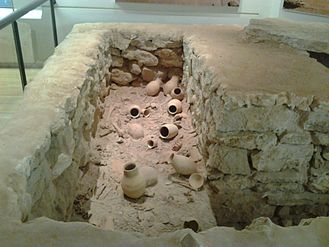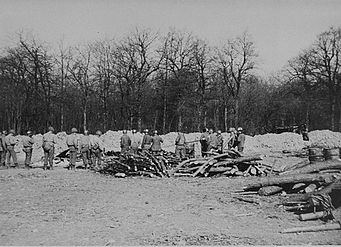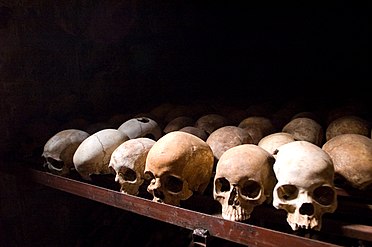Mass grave
A mass grave is a grave where several bodies are buried together, without coffins.
Some mass graves have just a few bodies.[1] Others are created when hundreds or thousands[2] of people die in mass murders, disease epidemics, genocides, or natural disasters.

Definitions
[change | change source]Not everybody defines "mass grave" the same way. Some sources say a mass grave just needs to contain "more than one" person.[1] According to the United Nations, a mass grave has three or more people buried together.[3] Another definition simply says that "a large" number of bodies are buried together in a mass grave.[3]
Other definitions have said that mass graves are:[3]
- Graves where bodies were buried with no respect for each individual person
- Graves where bodies are buried very closely together, packed tightly, without the dignity of a regular burial
- Group graves of people who were killed or executed without a trial, or without doing anything wrong
Disease
[change | change source]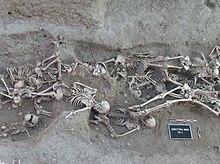
For centuries, humans have used mass graves when large numbers of people died at once from disease epidemics.
In these cases, the goal of the mass grave is not to disrespect the bodies of the dead. The goal is to prevent disease from spreading from the dead to the living. Also, if too many people have died, it may be impossible to bury them all separately.
The Black Death
[change | change source]Also see: The Black Death
Historians have found mass graves in Europe with victims of the Black Death (a very deadly 14th-century pandemic). At the time, people were terrified of catching the plague from dead bodies. Often they buried plague victims in mass graves.[4] Sometimes, people still tried to honor the dead with Christian burial traditions.[4]
Daniel Defoe, who lived during the Great Plague of London in 1655-1666, wrote about one mass grave:
| “ | A terrible pit it was, and I could not resist my curiosity to go and see it. [I]t was about forty feet in length, and about fifteen or sixteen feet [wide], and at the time I first looked at it, about nine feet deep; but it was said they dug it near twenty feet deep afterwards in one part of it, till they could go no deeper [because of] the water; for they had, it seems, dug several large pits before this. [5] | ” |
Disasters
[change | change source]More recently, victims of natural disasters have been buried in mass graves. Like with mass graves for disease victims, mass graves for disaster victims are not meant to disrespect the dead. In disasters where many people die, it may not be possible to bury each person one by one.
2010 Haiti earthquake
[change | change source]For example, after 2010 Haiti earthquake, there were tens of thousands of bodies in the Haitian capital city of Port-au-Prince. In the first nine days after the earthquake, about 90,000 people were buried in mass graves, using bulldozers.[6] There were so many bodies that there was no space, and not enough workers, to bury them one by one.
One Haitian man, who helped bury 2,500 people in three mass graves, said: "You have to understand that it's completely un-Haitian to dump bodies like this. We have extreme respect for the dead. And these people deserve a decent burial."[7] Later, he and other volunteers put up crosses to mark the graves, put holy water on the graves, and had a priest say prayers for the dead.[7]
2011 earthquake
[change | change source]Some areas in Japan had to use mass graves after the 2011 Tōhoku earthquake and tsunami. Usually in Japan, people are cremated after they die.[8] However, there were too many victims, and not enough kerosene to cremate them or dry ice to keep the bodies from decomposing. In one town, cremating all the town's victims would have taken 100 days.[8] Because of this, some towns had to use mass graves to bury the dead.
Murder and genocide
[change | change source]Throughout history, people and governments that have murdered many people have buried them in mass graves. Unlike mass graves for disease or disaster victims, this type of mass grave is often meant to disrespect the bodies of the dead after they are murdered.
Mass graves have been found from many of the international wars and civil wars in modern history. Here are a few examples.
World War I
[change | change source]During World War I, on July 19, 1916, about 2,300 British and Australian soldiers were killed in a battle with the German Army. In 2008, about 250 of their bodies were found in mass graves, where the Germans had buried them.[9]
World War II
[change | change source]The Holocaust
[change | change source]
During The Holocaust, Nazi Germany killed six million Jewish people and millions of other people.[10] Nobody knows exactly how many of these people are buried in mass graves. However, here are some examples of mass graves from Nazi murders:
- At the Babi Yar massacre in Ukraine, Nazi soldiers killed 33,771 Jewish people in two days, and buried them in a mass grave.[11][12]
- At the Rumbula massacre in Latvia, Nazis killed about 25,000 Jews in two days, and buried them in mass graves[13]
- At some of the Nazi concentration camps, like Buchenwald and Treblinka, the Nazis buried thousands of people in mass graves[14][15]
- At the Nazis' death camps, they cremated the people they killed and dumped their ashes together. For example, at Treblinka, a layer of human ashes 20 feet deep covered parts of the ground. At Auschwitz's death camp, people's ashes were thrown into fields, swamps, and ponds.[16] These areas might be thought of as mass graves too.
Soldiers' graves
[change | change source]During World War II, German soldiers who died when Nazi Germany invaded the Soviet Union were buried in mass graves in Eastern Europe. In 2013, the German War Graves Commission moved 70,000 soldiers from these mass graves to a cemetery in Russia. This was the 82nd cemetery the Commission had built to re-bury soldiers buried in mass graves. All together, the 82 cemeteries hold more than 800,000 German soldiers. The Commission says there are at least 250,000 more German soldiers buried in mass graves throughout Eastern Europe.[17]
The Soviet Union also used mass graves during World War II. For example, in the Piskaryovskoye Memorial Cemetery, they buried almost 500,000 civilians and soldiers in 186 mass graves. These people had died or been killed during the Siege of Leningrad.[17]
The Soviet Union
[change | change source]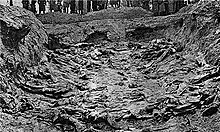
In the Soviet Union, as many as 20 million people may have died or been murdered while Joseph Stalin ruled the government.[18] Most of them were Soviet civilians. Many were buried in mass graves.
The biggest include:
- Bykivnia (between 100,000 and 225,000 people are buried here)[19][20]
- Kurapaty (between 30,000 and 250,000 people)[21][22]
- Butovo (over 20,000 people)[23]
- Communarka (about 10,000 people)[24]
- Sandarmokh (over 9,000 people)[25]
The Korean War
[change | change source]Early on in the Korean War, South Korea killed at least 100,000 people who had been put in prison for their political beliefs. They buried many of these people in mass graves. In 2007, the South Korean Truth and Reconciliation Committee found four mass graves, with more than 400 people in them. The Committee estimates that there are about 150 mass graves in South Korea.[26]
The Vietnam War
[change | change source]During the Vietnam War, in the Huế Massacre, the Viet Cong and the North Vietnamese Army murdered between 2,800 and 6,000 civilians and prisoners of war. They buried the bodies in dozens of mass graves.[27]
Genocide in Cambodia
[change | change source]From 1975 to 1979, the Khmer Rouge, ruled by Pol Pot, controlled Cambodia. The Khmer Rouge committed a genocide against the Cambodian people. Historians and scientists say that there are at least 20,000 mass grave sites in the country, holding at least 1,386,734 victims of execution.[28][29]
The Bosnian War
[change | change source]Also see: Bosnian War and Bosnian genocide

During the Bosnian War (1992-1995), the Bosnian Serb Army killed 8,000 Bosnian Muslims in the Srebrenica genocide and buried them in mass graves.[30]
In 2003, specialists found a mass grave that was "as big as a tennis court."[31] It included victims of the Srebrenica genocide. By 2006, 42 mass graves had been found around Srebrenica, and specialists think there are at least 22 more. Another 2,070 victims have been found in the graves.[32]
Other wars
[change | change source]During the Kosovo War (1998-1999), Serbian soldiers committed many war crimes against the Albanian people.[33] As of 2010, six mass graves had been found in Serbia with Albanian victims inside. The largest had between 705[34] and 1,000[35] bodies in it.
The Colombian government says that in its civil war, which is still going on today, its enemies have buried at least 6,000 people in mass graves.[36]
The terrorist group Islamic State of Iraq and Syria (ISIS) has buried victims in mass graves. As of 2017, more than 3,000 ISIS victims are buried in these graves across Iraq and Syria, according to the International Commission on Missing Persons.[2] In 2016, CNN wrote about a mass grave containing more than 130 men, women, and children who refused to join ISIS.[37]
Mass graves at residential institutions
[change | change source]Mother and baby homes
[change | change source]- Bethany Home: In 2010, the bodies of 222 infants from Bethany Home, were found in a mass unmarked grave in Dublin.[38]
- Bon Secours Mother and Baby Home
Canadian residential schools
[change | change source]This section is empty. You can help by adding to it. |
List of mass burials by location
[change | change source]| Date of deaths[A] | Event | Cause of deaths | Location | Then in | Now in | Coordinates | Longitude[B] |
|---|---|---|---|---|---|---|---|
| 1921 | Tulsa race massacre | Pogrom | Greenwood District, Tulsa, Oklahoma | 36°09′34″N 95°59′11″W / 36.1594°N 95.9864°W | -095° 59′ 11″ | ||
| 1967-06-08 | Ras Sedr massacre | Six Day War | Ras Sedr | Israeli occupation of the Sinai Peninsula | 29°35′30″N 32°42′20″E / 29.59167°N 32.70556°E | +032° 42′ 20″ | |
| El Arish massacre | El Arish | 31°07′55″N 33°48′12″E / 31.132072°N 33.803376°E | +033° 48′ 12″ | ||||
| 1967-06-?? | Six Day War | Mini Israel near Nahshon | 31°50′33″N 34°58′2.1″E / 31.84250°N 34.967250°E | +034° 58′ 02″ | |||
| 2013-11-?? | Typhoon Haiyan | Typhoon | Tacloban | +125° 00' | |||
| 2020-02-21 | COVID-19 pandemic in Iran | COVID-19 | Qom | 34°38′24″N 50°52′35″E / 34.64000°N 50.87639°E | +050° 52′ 35″ | ||
| 2020-03-?? | COVID-19 pandemic in New York | COVID-19[C] | Hart Island | 40°51′9″N 73°46′12″W / 40.85250°N 73.77000°W | -073° 46' 12" | ||
- ↑ year-month-day (YYYY-MM-DD)
- ↑ ranging from −180° West to +180° East.
- ↑ The increase in deaths was due to COVID-19, but the bodies that ended up buried on Hart Island died from a variety of causes. Hart Island has been used for many years as a burial ground for unclaimed bodies.
Photo gallery
[change | change source]- Hover over each photo to view its label. Click on the picture to make it bigger.
-
-
-
-
American soldiers in front of a mass grave for people killed at the Ohrdruf concentration camp. The mounds of dirt are people's ashes (1945)
-
Mass grave for people killed at Bergen-Belsen concentration camp. The engraving says "Here rest 5,000 dead. April 1945."
-
Mass grave for people killed by the Khmer Rouge in Cambodia (1975-1979)
-
Victims of the Rwandan Genocide (1994)
-
Mass graves for 70 children who died trying to reach a refugee camp in Kenya (2011)
Related pages
[change | change source]References
[change | change source]- ↑ 1.0 1.1 Smith, Dr Ellie (2021-04-01). "Universal Standards for Investigation of Mass Graves". European Journal of International Law: Talk!. Retrieved 2024-10-26.
- ↑ 2.0 2.1 Klinkner, Melanie (2017). "Towards Mass-Grave Protection Guidelines" (PDF). Human Remains and Violence. 3: 52–70.
- ↑ 3.0 3.1 3.2 Jugo, Admir; Wastell, Sari (2015). "Disassembling the pieces, reassembling the social: The forensic and political lives of secondary mass graves in Bosnia and Herzegovina". In Elisabeth Anstett; Jean-Marc Dreyfus (eds.). Human Remains and Identification: Mass violence, genocide, and the 'forensic turn'. Manchester University Press. ISBN 978-07190-97560.
- ↑ 4.0 4.1 Dick, HC; Pringle, JK; Sloane, B; Carver, J; Wisneiwski, KD; Haffenden, A; Porter, S; Roberts, D; Cassidy, NJ (2015). "Detection and characterisation of Black Death burials by multi-proxy geophysical methods" (PDF). Journal of Archaeological Sciences. 59: 132–141. doi:10.1016/j.jas.2015.04.010.
- ↑ Keltie, Sir John Scott, ed. (1870). The Works of Daniel Defoe. Minno. p. 468.
- ↑ Waterfield, Bruno (January 21, 2010). "Haiti earthquake: 10,000 buried each day in mass graves". The Telegraph Online. Telegraph Media Group Limited. Retrieved March 11, 2016.
- ↑ 7.0 7.1 Kraft, Scott (February 1, 2010). "Piles of the dead finally buried in Titanyen, Haiti's 'valley of death': With the government overwhelmed by the massive numbers of bodies, a businessman arranges to have about 2,500 moved into communal graves with backhoes". Los Angeles Times Online. Retrieved March 11, 2016.
- ↑ 8.0 8.1 Wakabayashi, Daisuke; Sekiguchi, Toko (March 22, 2011). "After Flood, Deaths Overpower Ritual: Prospect of Mass Graves Raises Tensions in Country Where Cremation is the Rule; a Shortage of Kerosene". The Wall Street Journal Online. Dow Jones & Company, Inc. Retrieved March 11, 2016.
- ↑ Greene, Richard Allen (February 1, 2010). "Unknown WWI soldier buried as mass graves give up secrets". CNN Online. Turner Broadcasting System, Inc. Retrieved March 11, 2016.
- ↑ "Introduction to the Holocaust: Animated Map". Holocaust Encyclopedia. United States Holocaust Memorial Museum. Retrieved March 11, 2016.
- ↑ Prusin, Alexander V. (Spring 2007). "A Community of Violence: The SiPo/SD and its Role in the Nazi Terror System in Generalbezirk Kiew". Holocaust Genocide Studies. 21 (1): 1–30. doi:10.1093/hgs/dcm001.
- ↑ Khiterer, Victoria (2004). "Babi Yar: The tragedy of Kiev's Jews" (PDF). Brandeis Graduate Journal. 2: 1–16. Archived (PDF) from the original on November 28, 2007. Retrieved March 11, 2016.
- ↑ Rhodes, Richard (2002). Masters of Death: The SS-Einsatzgruppen and the Invention of the Holocaust. New York: Vintage Books. pp. 206–209. ISBN 0-375-70822-7.
- ↑ "Ohrdruf". Holocaust Encyclopedia. United States Holocaust Memorial Museum. Retrieved March 11, 2016.
- ↑ "Treblinka: Revealing the hidden graves of the Holocaust". BBC Online. British Broadcasting Corporation, Inc. January 23, 2012. Retrieved March 11, 2016.
- ↑ "What proof exists that the Nazis practiced genocide or deliberately killed six million Jews?". The Nizkor Project. 2012. Archived from the original on March 7, 2016. Retrieved March 11, 2016.
- ↑ 17.0 17.1 Maranzani, Barbara (August 1, 2013). "Seven Decades After World War II, the Search for Germany's War Dead Continues". History.com. A&E Television Networks, LLC. Retrieved March 11, 2016.
- ↑ Werth, Nicolas; Panné, Jean-Louis; Paczkowski, Andrzej; Bartosek, Karel; Margolin, Jean-Louis (October 1999). Courtois, Stéphane (ed.). The Black Book of Communism: Crimes, Terror, Repression. Harvard University Press. p. 4. ISBN 978-0-674-07608-2.
- ↑ "Ukraine reburies 2,000 victims of Stalin's rule". Reuters. Thomson Reuters. October 27, 2007. Retrieved March 11, 2016.
- ↑ Hamm, Michael Franklin (1995). Kyiv. Princeton: Princeton University Press. ISBN 0-691-02585-1.
- ↑ Marples, David. "Days of Rememberance in Minsk". Eurasia Daily Monitor. 4 (204). The Jamestown Foundation. Retrieved March 11, 2016.
- ↑ (in Polish) Winnicki, Zdzislaw J. (2005). Szkice kojdanowskie. Wrocław: Wydawnictwo GAJT. pp.77-78. ISBN 83-88178-26-1
- ↑ Kishkovsky, Sophia (June 8, 2007). "Former Killing Ground Becomes Shrine to Stalin’s Victims". The New York Times. Retrieved March 11, 2016.
- ↑ (in Russian) "Спецобъект 'Монастырь'". ИЗВECTИЯ. October 11, 2007. Retrieved March 11, 2016.
- ↑ "Pictorial essay: Death trenches bear witness to Stalin's purges". CNN Online. Turner Broadcasting Network Inc. July 17, 1997. Retrieved March 12, 2016.
- ↑ "Thousands of Koreans executed early in the war: The mass executions have been largely hidden from history". NBC News Online. Associated Press. May 18, 2008. Retrieved March 11, 2016.
- ↑ Anderson, David L. (2004). The Columbia Guide to the Vietnam War. Columbia University Press. pp. 98-99. ISBN 978-0231114936
- ↑ "Mapping Project: 1995 to Present" Archived 2018-08-18 at the Wayback Machine. Document Center of Cambodia. Accessed March 11, 2016.
- ↑ "The CGP, 1994-2015". Cambodian Genocide Program. Yale University. 2010. Accessed March 12, 2016.
- ↑ "ICTY: The Conflicts". The International Criminal Tribunal for the former Yugoslavia. Retrieved March 12, 2016.
- ↑ "'Biggest ever' mass grave excavated". The Guardian Online. Guardian News and Media Limited. July 28, 2003. Retrieved March 11, 2016.
- ↑ Weinberg, Bill (July 11, 2006)."Srebrenica: 11 years later, still no justice". World War 4 Report. Retrieved March 12, 2016.
- ↑ "Judgement Summary" (PDF). Šainović et al. (IT-05-87). International Criminal Tribunal for the Former Yugoslavia. February 26, 2009. Retrieved March 12, 2016.
- ↑ Batajnica Summary Report: Forensic Monitoring Activities (PDF) (Report). International Commission on Missing Persons. 2004. p. 5. Archived from the original (PDF) on September 24, 2015. Retrieved March 12, 2016.
- ↑ Borger, Julian (May 10, 2010). "Kosovo Albanian mass grave found under car park in Serbia". The Guardian Online. Guardian News and Media Limited. Retrieved March 12, 2016.
- ↑ Moloney, Anastasia (July 17, 2015). "Colombia to unearth 'world's largest urban mass grave': official". Reuters. Thomson Reuters. Retrieved March 11, 2016.
- ↑ Elbagir, Nima (January 13, 2016). "Mass graves, missing children: Evidence of brutality in Iraqi town of Sinjar". CNN Online. Turner Broadcasting Network Inc. Retrieved March 11, 2016.
- ↑ O'Sullivan, Claire (2 April 2014). "Monument to Bethany Home's 222 dead children unveiled". Irish Examiner. Archived from the original on 3 March 2016. Retrieved 9 June 2014.

